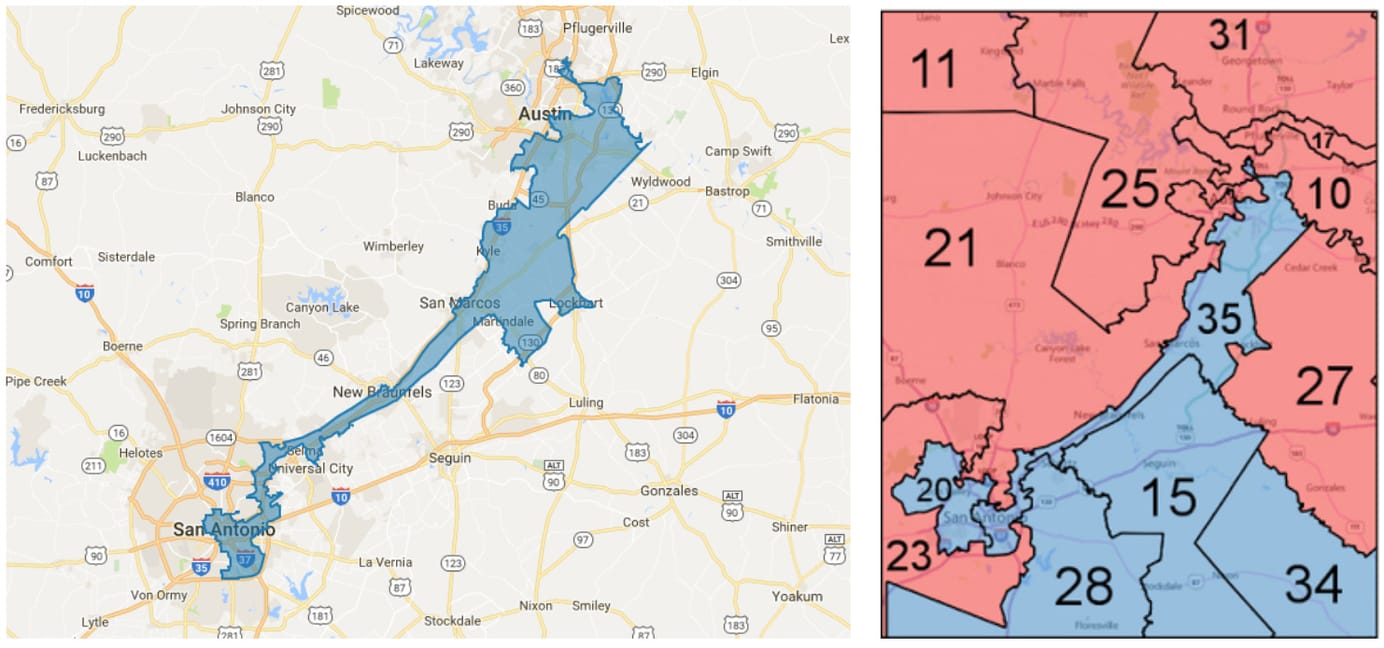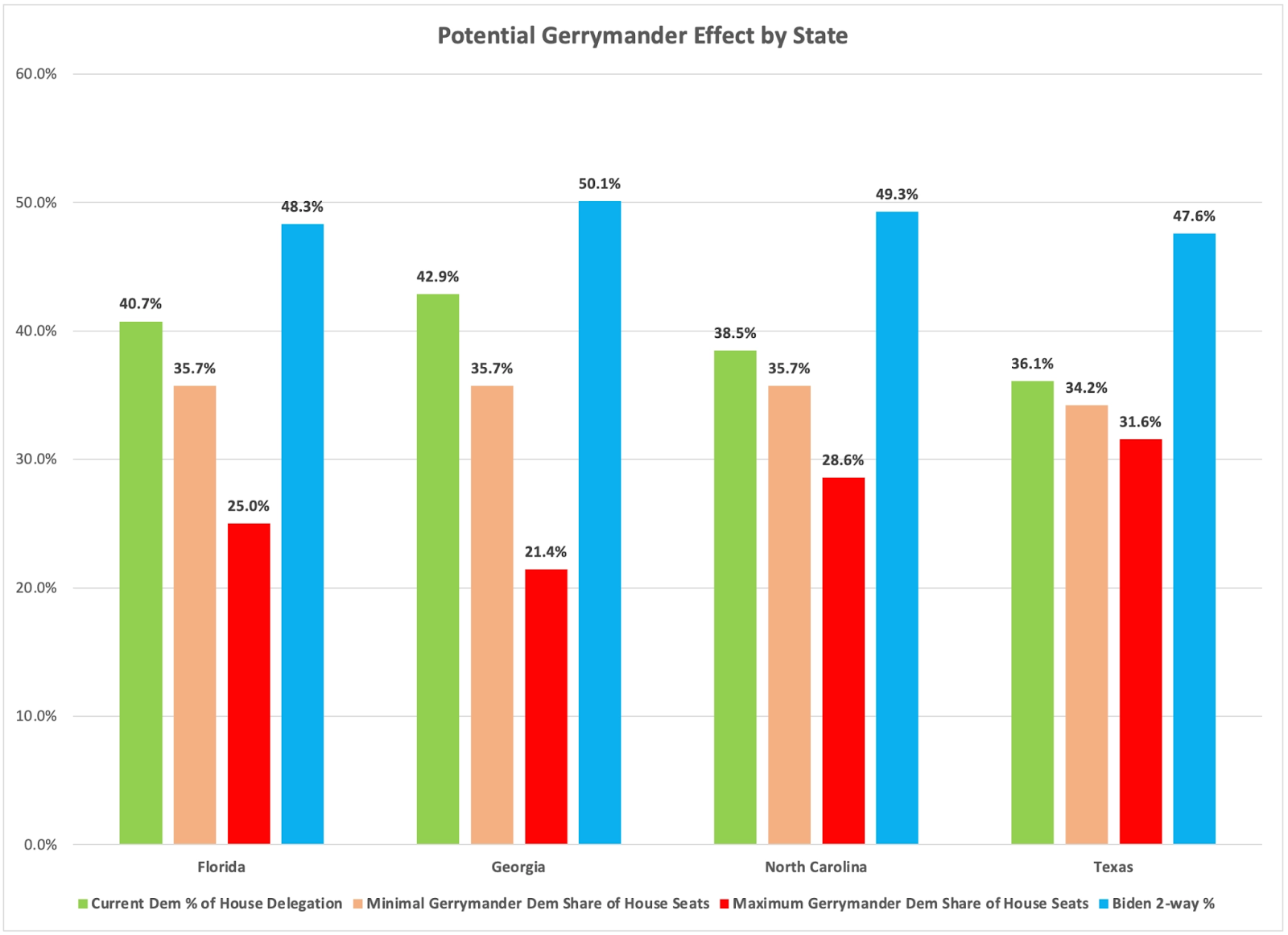
Gerrymandering a GOP Victory in 2022
Why You Can’t Out Organize Gerrymandering
Buried under the news of the Delta variant, Infrastructure bills, and Afghanistan, there was a major political event a few weeks back that went under-reported. On August 12th, the 2020 Census data was released for the states to redraw their voting districts for the next 10 years. (if you’re looking for a recap on the Census, I wrote about it in May)
Since Sinemanchin (and others) have blocked the elimination of the filibuster to allow the Senate to pass desperately needed democracy reforms, crucial states like Florida, Texas, Georgia, North Carolina, and Arizona will be redrawn by Republicans allowing them to gerrymander, or unfairly draw to advantage one party, the districts so that Democrats can’t win as many seats as the population would allow. The implications of this span all areas of politics. The Center for American Progress recapped the impacts of gerrymandering:
- Republicans wrongfully won an average of 19 House seats per election over the last 10 years.
- Approximately 42 million Americans are disenfranchised
- Republicans have a state government trifecta in 23 states (meaning they control the governor, state, and house) despite not having a population majority in most of those states.
And that’s with 2010 data! 2020 Census data is set to further disenfranchise voters as the population growth in the US came in Texas and Florida.
In fact, it’s widely acknowledged that the Republicans can regain control of the US House just by redistricting. Not better candidates, popular policies, or a more compelling message. Just because they can redraw the maps for themselves.
There is growing concern amongst activists and others in the Democratic party that party leadership has not grasped the stakes of the moment we find ourselves in. Recent news reports have the Biden Administration saying that we can “out-organize” the rampant voter suppression and gerrymandering.
- First, this is a huge slap in the face to anyone that worked their ass off in 2020 and the black and brown voters who have to stand in line for hours to vote.
- But secondly, it’s not that simple.

The Invisible Hand of Gerrymandering
Gerrymandering can be invisible which is why it feels like our democracy is deeply divided when in reality the Republicans have an unfair advantage in most aspects of our political system that makes it feel like there are more of them.
What the Biden Administration and other party leaders are proposing is for grassroots activists to
- Register more voters
- Motivate more voters
- Get more voters to the polls
While it’s hard to show just how much gerrymandering is impacting our democracy, I will make an attempt with a little bit of knurdiness.
Why You Can’t Out Organize Gerrymandering
First, let’s look at the stats. Democrats have narrow control of the House right now with only 4 seats to spare. (Reminder, the Democrat’s control of the House is tight precisely because of gerrymandering)

According to a report from TargetSmart, Republicans can easily gain control of the House in 2022 just by gerrymandering one state: Florida.
- Florida can draw 5 new GOP districts
- Texas can draw 2 or 3 new GOP districts (that’s impressive given how gerrymandered Texas already is)
- Georgia can draw 1 or 3 new GOP districts
- North Carolina can draw 1 or 2 new GOP districts
So just by the numbers, Democrats have lost the House 231 to 202 without even campaigning.
A Visual Representation of Suppression
But beyond the numbers, I want to paint the picture in real human terms.
When I wrote about the Census, I used Texas as a prime example for gerrymandering. Let’s revisit Austin for a second. That long squiggly line is the main district that represents Austin and San Antonio.
Seems like a really weird shape right? That’s by design. The GOP drew these maps so that the Democrat-leaning cities would be represented by one major district and then they broke up the rest of Austin and San Antonio so there was more rural representation in the other districts to secure more Republican districts.
So no matter how many people vote in Austin and San Antonio, they will have won one district. It doesn’t matter if they win by 90% of the vote, they only get one representative in the US and Texas House respectively. There is nothing that organizers can do about that.

One More Data Chart
As a data knurd, I could keep going, but I’m going to show one last chart to represent gerrymandering.
Looking at the below chart shows just how difficult it is to out-organize. The chart compares the state-wide votes for Joe Biden compared to the actual representation in the US house that is dictated by votes per district.
In the last election, Joe Biden won 46.5% of the vote in Texas which is pretty close to an equal split to Trump (about 630K votes). But when you look at the House districts, Democrats only make up 36% of the seats. That is gerrymandering in action. Over 10% of the Texas population’s vote is being suppressed simply because of where they chose to live.

Plus some state legislatures are enacting laws to allow GOP-controlled legislatures to overturn elections just because through “election administration laws”.
So, yeah, it’s not great. But I can’t just end with a negative. All hope is not lost.
We Know the Stakes; What Is the Solution?
First, we have to keep fighting on principle. The GOP wants us to feel defeated so that we don’t work as hard to fight for democracy. The GOP has turned authoritarian and wants to enact an oligarchy in the United States. We have to do everything we can to stop that.
Second, there are still tools (albeit limited) for Americans to stop gerrymandering.
- The Senate: Senators can get off their backsides, eliminate the filibuster, and pass the For the Peoples Act which bans gerrymandering and requires all states to be drawn by independent commissions. (Reminder, you can’t have bipartisanship if one party is authoritarian. That’s why we need election reform.)
- Activism: we can’t place all of our hopes on politicians in Washington. Common Cause has a great activist handbook on what steps you can take. https://www.commoncause.org/resource/redistricting-activist-handbook/
- The Law: nonprofits are gearing up to take the battle to the state courts by using the state constitution’s language like “free” or “fair” elections to claim the gerrymandered maps go against the state constitution.
Finally, I will note what the 2020 Census results show. As expected, the data show a historically diverse population, with growth almost entirely confined to the nation’s major metropolitan areas.
Republicans know that they are no longer the majority in this country and they’re scared. Our country is quickly becoming more diverse and urban. Our government should reflect that.
Before You Go!
Take our brand new survey! We’d love to learn a little bit about you and the issues you care most about.
Take our short 3 question survey: https://v3fxn5xhtiw.typeform.com/to/dbXix5CV
the roots of change media ecosystem Newsletter
Join the newsletter to receive the latest updates in your inbox.



